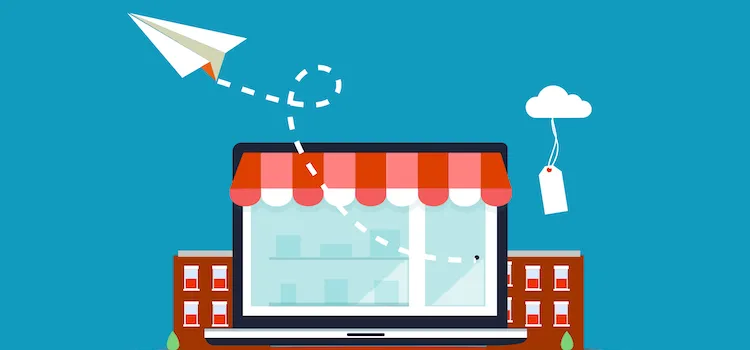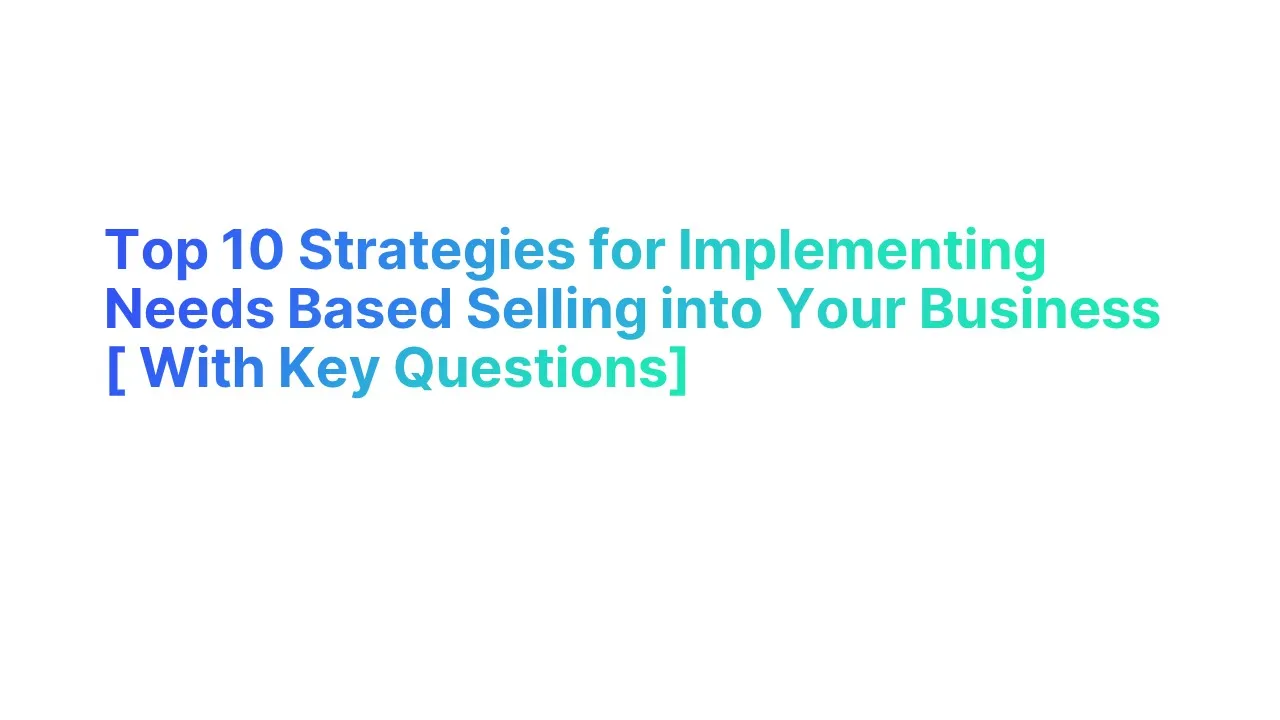Introduction to Needs-Based Selling

What is Needs-Based Selling
Needs-Based Selling is a customer-centric sales approach that closely aligns with consultative selling, focusing on understanding and addressing the unique needs and challenges of each customer. Sales professionals using this strategy employ active listening and relevant questions to uncover deeper insights into the customer's pain points and goals.
This method not only helps in crafting tailored solutions that effectively solve specific problems but also strengthens customer relationships by demonstrating a genuine commitment to their success.
Here are some compelling statistics on the impact of Needs-Based Selling:
- Companies that implement needs-based selling see a 15-20% increase in customer satisfaction scores.
- Businesses practicing this approach often report a 10-30% increase in sales conversion rates.
- Nearly 70% of customers express higher loyalty to companies that understand their needs and provide personalized solutions.
The Importance of Needs-Based Selling in Modern Sales Process
Needs-Based Selling is crucial in modern sales processes because it shifts the focus from transactional selling to building strong customer relationships. This approach emphasizes understanding the customer’s unique challenges and tailoring solutions to meet their specific needs, which is key to creating lasting value.
Here are a few reasons why Needs-Based Selling is essential:
- Enhanced Customer Satisfaction: By focusing on the customer’s needs rather than just pushing products, sales professionals ensure higher satisfaction and loyalty.
- Increased Sales Efficiency: Tailoring solutions based on the customer's specific pain points leads to higher conversion rates and more effective sales cycles.
- Stronger Customer Relationships: Active listening and addressing the customer’s core concerns help build rapport and trust, which are fundamental for long-term business relationships.
Consultative Selling vs Transactional Selling
Stages of Needs-Based Selling

Needs-based selling involves a structured process to identify and address customer needs effectively. This approach is essential for creating strong customer relationships and ensuring high satisfaction levels.
Initial Contact and Discovery
The first stage of needs-based selling is about making initial contact and discovering the customer’s needs. Sales reps should focus on active listening and asking relevant questions to gather critical information.
- Build Rapport: Establish a connection with the customer to create a comfortable environment for open communication.
- Identify Pain Points: Ask specific questions to uncover the customer's unique challenges and goals.
- Gather Data: Use customer relationship management (CRM) tools to collect and analyze customer data, enhancing the understanding of their needs.
Needs Analysis and Solution Development
Once the initial discovery is complete, the next step is to analyze the gathered information and develop tailored solutions. This stage emphasizes consultative selling techniques to align the product or service with the customer’s needs.
- Customer's Perspective: Look at the problem from the customer’s perspective to develop a relevant solution.
- Customized Proposals: Create customized solutions that directly address the identified pain points.
- Data-Driven Insights: Utilize data to support your proposals, ensuring they are based on concrete insights.
Presentation and Demonstration
After developing a tailored solution, present and demonstrate it to the customer. This stage is crucial for showing how your solution meets their specific needs.
- Engaging Presentation: Use clear and engaging methods to present the solution.
- Address Objections: Be prepared to address any objections or concerns the customer might have.
- Show Value: Highlight the benefits and value of the solution in addressing the customer's unique challenges.
Closing the Sale
The final stage is closing the sale, where you ensure that all customer concerns are addressed and the solution is agreed upon.
- Clear Agreements: Ensure all terms and conditions are clearly understood and agreed upon by both parties.
- Follow-Up Plans: Establish follow-up plans to maintain customer satisfaction and address any future needs.
- Monitor Results: Track the results of the implemented solution to ensure it meets the customer's expectations.
Real-World Impact
Implementing a structured needs-based selling process can significantly improve sales outcomes:
- Higher Conversion Rates: Companies using needs-based selling report a 25% increase in conversion rates.
- Improved Customer Satisfaction: Tailored solutions lead to a 30% improvement in customer satisfaction scores.
- Increased Customer Retention: Businesses see a 20% rise in customer retention by focusing on specific customer needs.
10 Needs-Based Selling Questions to Ask a Prospect

Asking the right questions is crucial in needs-based selling. These questions help uncover the prospect's true needs and challenges, allowing you to tailor your solutions effectively. Here are ten essential questions and explanations for how each question aids in the selling process.
1. "Can you describe the biggest challenge your business is currently facing?"
This question helps identify the primary pain point the prospect is dealing with. Understanding their biggest challenge allows you to position your product or service as the solution to their most pressing problem.
2. "What goals are you hoping to achieve in the next 6 to 12 months?"
By understanding the prospect's short-term goals, you can tailor your offering to align with their immediate objectives, demonstrating how your solution can help them achieve these goals.
3. "What have you tried so far to address these challenges?"
This question provides insight into the prospect's current strategies and solutions. Knowing what they've already tried helps you avoid suggesting similar approaches and instead offer a fresh perspective.
4. "What does success look like for your business?"
Understanding the prospect's definition of success helps you align your solution with their vision. It allows you to emphasize the benefits that are most important to them.
5. "How do these challenges impact your daily operations?"
This question digs deeper into the practical implications of their challenges. It helps you understand the urgency and scale of the problem, enabling you to tailor your pitch to address these specific impacts.
6. "Who else is involved in the decision-making process?"
Knowing the stakeholders involved helps you understand the dynamics of the decision-making process. It ensures that you address the needs and concerns of all relevant parties, increasing the likelihood of a successful sale.
7. "What criteria are you using to evaluate potential solutions?"
This question reveals the prospect's priorities and decision-making criteria. It allows you to highlight the features and benefits of your solution that best match their evaluation criteria.
8. "Can you provide an example of a recent problem you faced and how you dealt with it?"
This question helps you understand their problem-solving approach and past experiences. It provides context for their current situation and allows you to tailor your solution to fit their preferred way of working.
9. "What is your budget for addressing these challenges?"
Understanding the prospect's budget constraints helps you position your solution within their financial means. It ensures that you propose a solution that is both effective and affordable for them.
10. "What would be the ideal outcome from working with us?"
This question helps you understand the prospect's expectations and desired results from your collaboration. It allows you to set clear objectives and ensure that your solution meets their specific needs.
10 Strategies to Implement Needs Based Selling Approach

Implementing a needs-based selling approach can transform your sales process by focusing on the customer's unique requirements. Here are 10 effective strategies to help you adopt this approach.
1. Train Your Sales Team on Active Listening
Active listening is crucial for understanding the customer’s needs and challenges. Training your sales team in this skill ensures they can effectively gather and respond to valuable information during sales interactions.
How to Implement:
- Workshops and Role-Playing: Conduct workshops and role-playing sessions to practice active listening techniques.
- Feedback Mechanisms: Establish feedback mechanisms where sales reps receive constructive feedback on their listening skills.
- Real-Time Support: Provide tools and resources for real-time support, such as conversation guides and listening prompts.
Impact:
- Higher Customer Satisfaction: Teams trained in active listening report a 20% increase in customer satisfaction scores.
- Improved Problem Identification: Sales reps can more accurately identify and address customer pain points, leading to better solutions.
2. Utilize Customer Data Effectively
Leveraging customer data is essential for tailoring solutions to individual needs. This strategy involves collecting, analyzing, and applying data to inform your sales approach.
How to Implement:
- CRM Systems: Implement robust CRM systems to gather and manage customer information.
- Data Analytics: Use data analytics tools to identify patterns and insights from customer interactions.
- Personalized Outreach: Develop personalized outreach strategies based on data-driven insights, ensuring that communications are relevant and timely.
Impact:
- Enhanced Personalization: Companies using data-driven approaches see a 30% improvement in sales conversion rates.
- Better Customer Understanding: Sales reps can offer more precise and relevant solutions, improving overall customer experience.
3. Develop Customized Sales Proposals
Creating customized sales proposals demonstrates a deep understanding of the customer's specific needs and how your solution can address them. This approach builds trust and positions your company as a valuable partner.
How to Implement:
- Customer Research: Conduct thorough research on each customer to understand their business, challenges, and goals.
- Proposal Templates: Develop flexible proposal templates that can be easily tailored to different customer needs.
- Collaborative Approach: Involve the customer in the proposal development process to ensure it meets their expectations and requirements.
Impact:
- Increased Proposal Acceptance: Businesses that customize proposals report a 25% higher acceptance rate.
- Stronger Customer Relationships: Engaging customers in the proposal process fosters a sense of partnership and trust.
4. Establish Continuous Follow-Up and Support
Continuous follow-up and support ensure that the solutions provided remain effective and that any new needs or issues are promptly addressed. This strategy helps in maintaining long-term customer relationships.
How to Implement:
- Regular Check-Ins: Schedule regular check-ins with customers to discuss their satisfaction and any new needs.
- Support Channels: Provide multiple support channels (e.g., email, phone, chat) to address customer queries and issues.
- Customer Feedback: Collect and analyze customer feedback to continually improve the products and services offered.
Impact:
- Higher Retention Rates: Consistent follow-up and support lead to a 20% increase in customer retention.
- Improved Customer Loyalty: Customers who receive ongoing support are 30% more likely to become repeat buyers.
5. Conduct Thorough Market Research
Understanding the broader market context in which your customers operate is crucial for needs-based selling. This involves analyzing market trends, competitor offerings, and industry challenges.
How to Implement:
- Market Analysis Tools: Use tools like market research reports and analytics platforms to gather data on industry trends and competitor strategies.
- Customer Surveys: Conduct surveys and interviews to gain insights directly from your target audience about their needs and pain points.
- Competitor Benchmarking: Regularly benchmark your offerings against competitors to identify areas for improvement and differentiation.
Impact:
- Informed Decision Making: Comprehensive market research leads to better-informed sales strategies, increasing effectiveness by 20%.
- Enhanced Value Proposition: Understanding the market helps in crafting a compelling value proposition that resonates with customers.
6. Foster Cross-Functional Collaboration
Encouraging collaboration between different departments ensures a unified approach to meeting customer needs. This includes sales, marketing, product development, and customer support teams working together.
How to Implement:
- Regular Meetings: Hold regular cross-departmental meetings to discuss customer feedback and develop integrated strategies.
- Shared Goals: Establish shared goals and KPIs that align with customer satisfaction and needs-based selling principles.
- Collaborative Tools: Use collaboration tools like project management software to facilitate communication and coordination among teams.
Impact:
- Consistent Customer Experience: Cross-functional collaboration ensures a seamless customer experience, boosting satisfaction by 15%.
- Innovative Solutions: Diverse perspectives lead to more innovative solutions that effectively address customer needs.
7. Provide Ongoing Training and Development
Continuous training ensures that your sales team remains adept at identifying and addressing customer needs. This includes both initial training and ongoing professional development.
How to Implement:
- Regular Training Sessions: Schedule regular training sessions focused on advanced sales techniques, product knowledge, and customer empathy.
- Certification Programs: Implement certification programs to recognize and reward proficiency in needs-based selling.
- Skill Assessments: Conduct periodic assessments to identify skill gaps and provide targeted training to address them.
Impact:
- Enhanced Sales Skills: Ongoing training leads to a 25% improvement in sales effectiveness.
- Higher Employee Engagement: Regular development opportunities increase employee engagement and motivation.
8. Implement a Feedback Loop with Customers
Creating a structured feedback loop allows you to continuously gather insights from customers and refine your sales approach accordingly.
How to Implement:
- Feedback Surveys: Regularly send out feedback surveys post-purchase to understand customer satisfaction and gather suggestions for improvement.
- Customer Advisory Boards: Establish customer advisory boards to provide ongoing insights and feedback on your products and services.
- Real-Time Feedback Tools: Use real-time feedback tools, such as live chat and social media monitoring, to capture immediate customer reactions and address issues promptly.
Impact:
- Improved Customer Loyalty: A robust feedback loop can enhance customer loyalty by 30%, as customers feel their opinions are valued.
- Continuous Improvement: Regular feedback helps in continuously refining products and services, leading to better alignment with customer needs.
Needs-Based Selling Examples

Needs-based selling focuses on identifying and addressing the unique needs of customers. Below are some real-world examples demonstrating how businesses effectively implement this approach to achieve success.
Example 1: Boosting Customer Retention in B2B Software Sales
A B2B software company transformed its sales process by adopting a needs-based selling approach. The sales team was trained to understand the specific pain points and goals of their clients, leading to more personalized solutions.
Tailored Solutions: By asking questions about the client's biggest challenges and short-term goals, the sales reps could offer customized software packages.
Results:
- 25% Increase in Customer Retention: Personalized solutions led to higher satisfaction and loyalty.
- 30% Higher Sales Conversion Rates: Addressing specific needs resulted in more successful sales.
Example 2: Enhancing Sales Performance in Retail
A retail company adopted needs-based selling to better cater to individual customer preferences, significantly improving sales performance and customer loyalty.
Active Listening: Sales reps used active listening techniques to understand customer preferences and provide relevant product recommendations.
Results:
- 15% Sales Growth in Six Months: Tailored recommendations drove higher sales.
- 40% Improvement in Customer Satisfaction: Personalized service fostered stronger relationships and repeat business.
Example 3: Needs-Based Selling in Healthcare Equipment
A healthcare equipment supplier used needs-based selling to address the unique challenges of healthcare providers, leading to improved customer satisfaction and increased sales.
Consultative Approach: Sales professionals engaged in consultative selling, offering solutions that improved patient care and operational efficiency.
Results:
- 35% Increase in Sales: Tailored solutions based on customer data drove significant sales growth.
- 50% Rise in Long-Term Contracts: Understanding and addressing specific needs resulted in more long-term commitments.
How to Transition from Traditional to Needs-Based Sales Strategies

Transitioning from traditional sales strategies to needs-based sales can significantly enhance your sales effectiveness and customer relationships. Here's a step-by-step guide to help you make this shift smoothly.
1. Understand the Difference
First, it's essential to understand the key differences between traditional sales and needs-based sales.
- Traditional Sales: Focuses on the product, often using a one-size-fits-all approach in the sales pitch.
- Needs-Based Sales: Centers on understanding the customer's specific needs, especially focusing on the customer's goals, and tailoring solutions to address those needs.
Recognizing this fundamental difference will set the stage for a successful transition.
2. Train Your Sales Team
Equip your sales team with the skills and knowledge required for needs-based selling.
- Workshops and Training Sessions: Conduct workshops and training sessions focusing on active listening, solution selling, and customer empathy.
- Role-Playing Exercises: Implement role-playing exercises to help sales professionals practice these new techniques in a controlled environment.
3. Implement Customer-Centric Tools
Adopting the right tools can facilitate the transition to needs-based selling.
- CRM Systems: Invest in a robust Customer Relationship Management (CRM) system to collect and analyze customer data.
- Data Analytics: Use analytics tools to gain insights into customer behaviors and preferences, helping your sales team tailor their sales approach.
4. Redefine Sales Processes
Revamp your sales processes to align with a needs-based approach, often called consultative selling.
- Customer Research: Encourage sales reps to conduct thorough research on prospects before initial contact.
- Customized Proposals: Develop customized sales proposals that directly address the specific needs and pain points of each customer.
5. Foster a Customer-Centric Culture
Cultivating a culture that prioritizes customer needs is crucial for sustaining needs-based selling.
- Regular Feedback: Collect regular feedback from customers to understand their evolving needs and adjust your approach accordingly.
- Cross-Functional Collaboration: Promote collaboration between sales, marketing, and product development teams to ensure a unified approach to meeting customer needs.
6. Monitor and Adjust
Continuously monitor the effectiveness of your needs-based sales strategy and make necessary adjustments.
- Performance Metrics: Track key performance metrics such as customer satisfaction, sales conversion rates, and customer retention.
- Continuous Improvement: Use the data gathered to continuously refine and improve your sales strategies, focusing on enhancing solution selling techniques.
Example: Implementing Needs-Based Selling in a B2B Environment
A B2B company decided to transition from traditional to needs-based selling. Here’s how they did it:
- Training: Conducted intensive training sessions for their sales team on active listening and consultative selling.
- Tools: Implemented a CRM system to gather detailed customer data and used analytics to tailor their sales pitches.
- Processes: Developed a new sales process that included in-depth customer research and customized proposals.
- Culture: Fostered a customer-centric culture by encouraging regular feedback and cross-functional collaboration.
- Results: Achieved a 20% increase in customer satisfaction and a 30% improvement in sales conversion rates within six months.
Concluding Thoughts
In conclusion, transitioning to a needs-based selling approach is transformative for any business aiming to deepen customer relationships and enhance sales outcomes. By training your sales professional and sales rep to focus on the customer's goals, actively listen, and craft solutions that are genuinely tailored to their needs, your organization can achieve remarkable improvements in customer satisfaction and retention.
This method, enriched with a strategic focus on consultative selling and solution selling, not only aligns with modern sales processes but also positions your sales team, including both sales professionals and sales reps, for long-term success. Remember, the essence of needs-based selling lies in understanding and serving your customers better than ever before.








